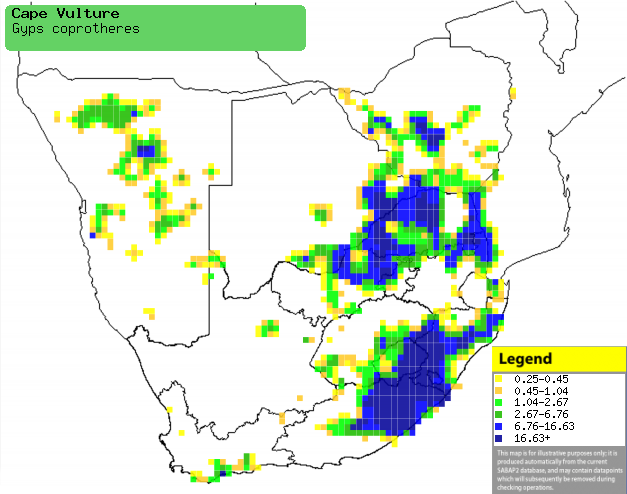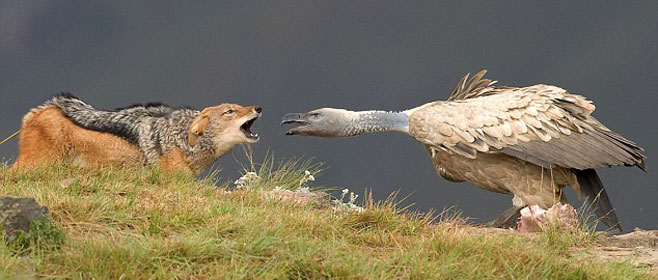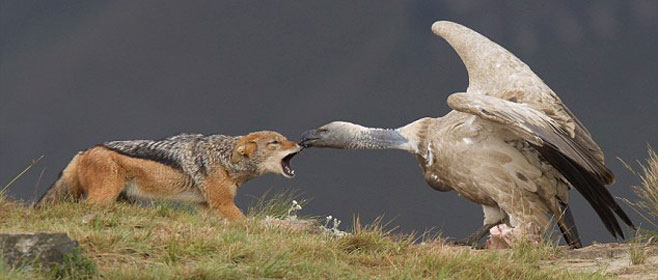|
Gyps coprotheres (Cape
vulture)
KransaasvoŽl [Afrikaans]; Ixhalanga [Xhosa]; iNqe [Zulu];
Ekuvi (generic term for vulture) [Kwangali]; Lenong, Letlaka [South
Sotho]; Khoti, Mavalanga [Tsonga]; Diswaane, LenŰng [Tswana]; Kaapse gier
[Dutch]; Vautour chassefiente [French]; Kapgeier [German]; Grifo do Cabo
[Portuguese]
Life
> Eukaryotes >
Opisthokonta
> Metazoa (animals) >
Bilateria >
Deuterostomia > Chordata >
Craniata > Vertebrata (vertebrates) > Gnathostomata (jawed
vertebrates) > Teleostomi (teleost fish) > Osteichthyes (bony fish) > Class:
Sarcopterygii (lobe-finned
fish) > Stegocephalia (terrestrial
vertebrates) > Tetrapoda
(four-legged vertebrates) > Reptiliomorpha > Amniota >
Reptilia (reptiles) >
Romeriida > Diapsida > Archosauromorpha > Archosauria >
Dinosauria
(dinosaurs) > Saurischia > Theropoda (bipedal predatory dinosaurs) >
Coelurosauria > Maniraptora > Aves
(birds) > Order: Falconiformes
> Family: Accipitridae
> Genus: Gyps
Distribution and habitat
Near-endemic to southern Africa, occurring in patches of Namibia, southern Zimbabwe, Lesotho
and north-eastern and south-eastern South Africa, with a localised population in
the Western Cape; it is a rare vagrant to Angola. It can occupy a variety of habitat types, although it
especially favours subsistence farming communal grazing areas, where there is plenty of
livestock to feed on.
|
 |
|
Distribution of Cape vulture in southern Africa,
based on statistical smoothing of the records from first SA Bird Atlas
Project (©
Animal Demography unit, University of
Cape Town; smoothing by Birgit Erni and Francesca Little). Colours range
from dark blue (most common) through to yellow (least common).
See here for the latest distribution
from the SABAP2. |
Predators and parasites
Its eggs are eaten by Papio ursinus (Chacma baboon),
and the chicks are prey of Aquila verreauxii (Verreauxs'
eagle).
Movements and migrations
Resident and partially nomadic, as adults may
travel up to about 750 km from their colony in the non-breeding
season.
Food
It eats carrion, searching aerially for a carcass to feed
on; once on the scene it is dominant over almost all other vultures, except the
larger Lappet-faced vulture. It slices
off flesh with the sharp edge of its bill, eating some of it and storing more in it's
crop, which can sustain it for about three days.
 |
|
A Black-jackal challenges a Cape vulture for a
piece of meat, Giant's Castle, South Africa. [photo Johann Grobbelaar
©] |
 |
|
The vulture bites the jackal on the nose, which
causes it to retreat. [photo Johann Grobbelaar
©] |
Breeding
- Monogamous colonial nester, breeding in colonies of up to about 1000
breeding pairs, each separated by roughly 2.5 metres.
- The nest is mainly built by the female, consisting of a bulky platform
of sticks, twigs and dry grass, with a shallow cup in the centre lined with
smaller sticks and grass. It is typically placed on a cliff ledge, often
using the same site over multiple breeding seasons.
- Egg-laying season is from May-June.
- It usually lays a single egg (rarely two), which is incubated by both
sexes for about 55-59 days.
- The chick is brooded constantly for the first 72 days of its life, while
both parents feed it on meat and bone fragments for calcium. It eventually
leave the nest at about 125-171 days old, becoming fully independent about
15-221 days later; the fledgling is always chased off the territory by its parents at
the start of the following egg-laying season.
Threats
Vulnerable globally, Regionally extinct in
Swaziland and Critically Endangered in Namibia; its global population has
decreased from roughly 3460 breeding pairs in 1980 to about 2950 pairs in 2000.
This is thought to have been caused largely by habitat loss, persecution for use
in traditional medicine, human disturbance of colonies, poisoning and
improvements in animal husbandry, which result in a decreased availability of
carrion.
References
-
Hockey PAR, Dean WRJ and Ryan PG 2005. Roberts
- Birds of southern Africa, VIIth ed. The Trustees of the John Voelcker
Bird Book Fund, Cape Town.
|
